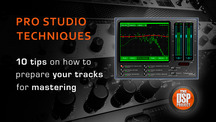In this video mastering engineer Rupert Brownfrom the The DSP project, guides us through his top 10 tips for preparing your tracks for mastering. Rupert includes tips on exporting, master bus settings, output levels, dithering, and comparing your audio to similar commercial recordings to help frame your mix.
About the mastering process
Mastering, is the process of preparing and transferring recorded audio from a source containing the final mix to a data storage device (the master).
Mastering requires critical listening and mastering engineers may need to apply corrective equalization and dynamic enhancement in order to optimise sound.
The source material, ideally at the original resolution, is processed using equalization, compression, limiting, noise reduction and other processes. More tasks, such as editing, pre-gapping, leveling, fading in and out, noise reduction and other signal restoration and enhancement processes can be applied as part of the mastering stage. This step prepares the music for either digital or analog, e.g. vinyl, replication. The source material is put in the proper order, commonly referred to as assembly (or ‘track’) sequencing.
Typical steps of the process
- Transferring the recorded audio tracks into the Digital Audio Workstation (DAW)
- Sequence the separate songs or tracks (the spaces in between) as they will appear on the final release.
- Process or “sweeten” audio to maximize the sound quality for its particular medium (e.g. applying specific EQ for vinyl).
- Transfer the audio to the final master format.
Possible actions taken during mastering
- Editing minor flaws
- Applying noise reduction to eliminate clicks, dropouts, hum and hiss
- Adjusting stereo width
- Adding ambience
- Equalize audio across tracks
- Adjust volume
- Dynamic range expansion or compression
- Peak limit
Visit Echoplex Mastering – Loopmasters no.1 preferred mastering service for special discounted introductory offers
Enjoy!









